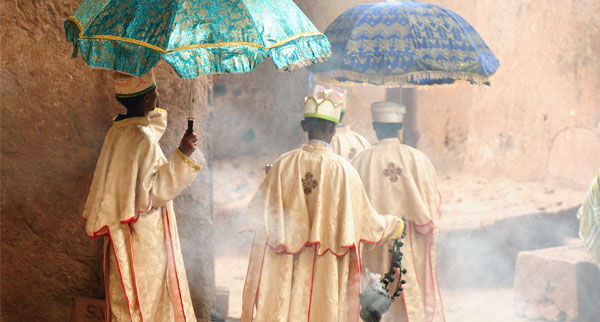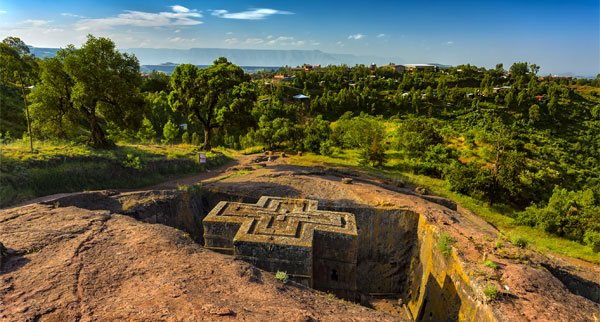Ethiopia offers wildlife spotting and ancient monuments without the crowds, finds Ella Buchan.
Click here to download and save as a PDF.
We were surrounded on all sides. Dozens of gelada or ‘bleeding-heart’ monkeys played, preened, groomed and grazed in the cliff-top meadows as we sat among them, watching in breathless silence.
Infants tumbled in the grass, mothers sauntered past with babies clinging to their backs, and imposing adult males – their golden manes reminiscent of Tina Turner’s signature hairstyle – let out low, gurgling grunts and puffed out their scarlet chests.
Some were so close, I could feel their hair brush against my skin as they passed. But, aside from the occasional sideways glance to check we were behaving, they barely registered our presence.
The monkeys, which graze all day and sleep in the cliffs, are endemic to Ethiopia’s Simien Mountains National Park. Here, visitors are completely surrounded by wildlife, rather than viewing from a distance.
Guests staying at nearby Simien Lodge sometimes come here to meditate or practise yoga, our guide Eyob Awraris told us, finding the monkeys’ presence calming.
Ethiopia overflows with experiences you just can’t find anywhere else, from rare wildlife in the mountains to the churches of Lalibela, hewn from single chunks of rock.
Because Ethiopia is so vast, an escorted tour makes sense, especially for first-time visitors. Several operators including Saga, who I travelled with, offer small-group trips led by local guides, exploring the country’s cultural and natural highlights.
Natural wonders
From mountain peaks and plateaus to cloud forests, lakes and fields of wheat and teff (a grain used to make the ubiquitous injera flatbreads), Ethiopia’s varied landscape makes it difficult to pin down.
This dramatic natural beauty is a big draw for many visitors, who come to comb the landscape and spy native birds and wildlife.
Yet, compared with popular safari destinations, most parts of the country are still relatively quiet, especially outside the busy winter season. I frequently spotted the same faces as I travelled, bumping into one couple at three locations, several hundred miles apart.
In the north, the rugged Simien Mountains are roamed by curved-horned walia ibex, an endangered wild goat you won’t find anywhere else, and about 150 miles south of the capital, Addis Ababa, Bale Mountains National Park is the best place to see Ethiopian wolves – the world’s rarest canid, with fewer than 500 in the wild.
They look like elegant foxes, with vivid copper coats, long, narrow jaws and tails tipped in black. While some stalk the Simiens, most live on the Sanetti Plateau, whose open, stark landscape increases the chances of spotting them.
This part of the country is like something from a fairy tale. The Harenna Forest clings to the lower slopes of the mountains, thick with giant fig trees coated in velvety moss and dripping with lichen.
Endangered black-maned lions have been sighted in this cloud forest, while tiny Bale monkeys hide in bamboo groves. Colobus monkeys, with jet-black fur, snow-white beards and long tails like curtain pulls, are easier to spot, as are birds such as white-cheeked turacos and tiny gold and green bee-eaters.
Cultural capital
Most visitors arrive in Ethiopia via Addis Ababa, and the capital has plenty to occupy them for a few days.
Suggest starting at the National Museum of Ethiopia, surrounded by lilac-flowered jacaranda trees, for an overview of the country’s history. Among the archaeological treasures is ‘Lucy’, the 3.2-million-year-old fossil of an early human ancestor. It’s locked away for preservation purposes, but visitors can view a cast.
For a more modern dose of culture, the sprawling open-air Merkato is a hectic hodgepodge of stalls selling leather goods, fruit and veg, honey and mattresses.
Many people come to Ethiopia for its palaces and religious sites, including some of the world’s oldest Christian churches. Gondar’s Royal Enclosure houses several grand emperors’ palaces, and visitors can wander around the well-preserved remains of banquet halls, libraries and ceremonial sites.

From there, Lalibela is a short flight away. And the journey provides a hint of what’s to come, with the plane swooping above incredible rose-hued rock churches. Even those not especially interested in religious monuments will feel their eyes widen and their breath catch when they see the structures up close.
Two groups of churches, with 11 structures in total, can be explored on foot via tunnels, steep stone steps and vertiginous bridges. Inside are faded frescoes, ornate carvings and reliefs. Bete Giyorgis, or St George, is perhaps the most incredible, carved in a cross shape from a single hunk of rock.
Legend suggests King Lalibela, who reigned in the 12th and 13th centuries, carved each of these churches aided only by the angels. Logic suggests he may have had a little help from thousands of slaves. Either way, their existence beggars belief.
Clients interested in religious history should head to Unesco World Heritage Site Aksum, whose city ruins, castles and royal tombs date back to the first century AD. St Mary of Zion is believed to have contained the biblical Ark of the Covenant, now kept in the neighbouring Chapel of the Tablet.

Mountain retreats
The best accommodation in Ethiopia blends beautifully with its surroundings – which is how it should be, with surroundings as incredible as this.
Limalimo Lodge is one of the country’s most modern hotels, and perhaps the best choice for clients looking to relax a little between adventures. Its terrace juts above the peaks of the Simiens and, around the grounds, hammocks are strung between acacia trees. The stylish thatched rooms have plush beds and windows overlooking wooded hillsides. Rates start at $255 per night for a double room including food and drink, and a $10 conservation charge.
In Lalibela, the Maribela Hotel is built high into an escarpment for dramatic views of the Ethiopian highlands. Rooms have terraces with daybeds to make the most of the view. Though, with bearded vultures often swooping below, you might struggle to doze off. Doubles from $99 per night, including breakfast.
The wooden chalets at Bale Mountain Lodge are scattered around a forest clearing, with a few stone huts next to the main building and restaurant, ideal for clients who might struggle with the narrow, winding paths. Prices start at $340 per room, including all meals, drinks and one excursion on foot per day.
The lodge organises activities including tracking wolves and visiting a coffee village, where wild berries are sorted and dried on huge mesh racks. The tour is an opportunity to take part in Ethiopia’s coffee ceremony, a ritualistic, social occasion that, like most things in this country, is well worth taking a little time over.
A bird-spotters guide to Ethiopia
Bearded vulture: This surreallooking bird – also known as the lammergeier – can swallow bones whole. They smash animal carcasses by dropping them from a height, so they can swoop down and pick over the remains.
Yellow-fronted parrots: These birds – which are actually a vibrant shade of green, with a bright-yellow face – are endemic to Ethiopia, and can be found in the trees around vast Lake Tana, source of the Blue Nile River.
Flamingos: The lakes of the Rift Valley, a giant trough that, in effect, slices the country in two, are a twitcher’s dream. There are fish eagles, marabou storks and pelicans and, at Lake Abijatta, hundreds of thousands of flamingos flutter over the water like rose petals in the breeze.
Book it
Saga’s 12-night escorted tour, Ethiopia: An Antique Land, costs from £2,999 based on a November 13 departure. The price includes Ethiopian Airlines flights from Heathrow, transfers, Saga tour manager, all meals and optional travel insurance (price reduction available without insurance).
travel.saga.co.uk
Ethiopian Airlines flies daily from Heathrow and four times a week from Manchester to Addis Ababa, with return fares starting at £495 in economy and £1,927 in business class, including taxes.
ethiopianairlines.com
Read more
Exploring undiscovered Sierra Leone
The wild side of Uganda
Wildlife and culture in Eswatini




